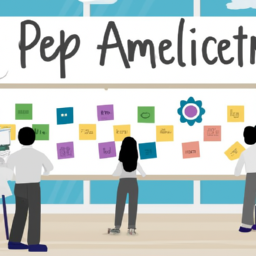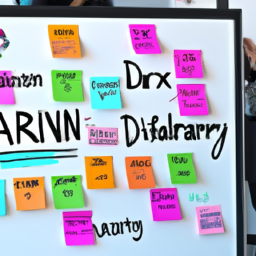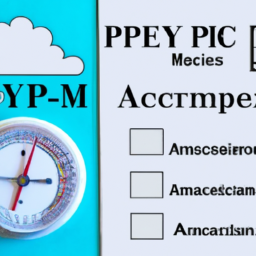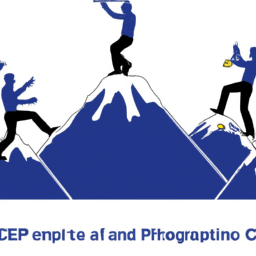Are you ready to decode the PMI ACP exam topics and gain the knowledge you need? Look no further because this article has everything you’re looking for.
From agile principles and values to frameworks and methodologies, we’ll guide you through each topic, providing concise and organized information.
With our detail-oriented approach, you’ll be well-prepared to tackle the exam.
So, get ready to dive into the world of PMI ACP and become a certified agile practitioner.
Key Takeaways
- Agile principles and values emphasize collaboration, adaptability, and continuous improvement.
- Scrum methodology is a popular framework in Agile project management.
- Agile planning involves breaking down projects into smaller tasks and utilizing techniques like velocity tracking and burndown charts for estimation.
- Effective communication and collaboration, along with regular team meetings and daily stand-ups, are crucial for Agile projects.
Agile Principles and Values
Agile principles and values are at the core of successful project management in today’s fast-paced business environment. Having an agile mindset means embracing the principles outlined in the Agile Manifesto.
This mindset emphasizes the importance of collaboration, adaptability, and continuous improvement. Agile project management focuses on delivering value to customers, responding to change quickly, and fostering self-organizing teams.
The Agile Manifesto, created by a group of software developers, highlights four key values: individuals and interactions over processes and tools, working software over comprehensive documentation, customer collaboration over contract negotiation, and responding to change over following a plan.
Agile Frameworks and Methodologies
Explore various frameworks and methodologies utilized in the Agile approach to project management.
Agile project management is a flexible and iterative approach that allows teams to adapt to change and deliver value to customers quickly.
One popular framework in Agile project management is the Scrum methodology. Scrum follows a set of roles, events, and artifacts to facilitate effective teamwork and project delivery. It emphasizes transparency, inspection, and adaptation.
Scrum teams work in short iterations called sprints, where they plan, execute, and review their work. Daily stand-up meetings provide a platform for collaboration and progress updates.
Additionally, Scrum boards and backlogs help teams visualize and prioritize their work. By implementing the Scrum methodology, teams can improve productivity, collaboration, and customer satisfaction in their Agile projects.
Agile Planning and Estimation
Get started with agile planning and estimation by breaking down your project into smaller tasks and assigning time estimates to each one. This will help you better understand the scope of your project and enable you to effectively plan and prioritize tasks.
Here are three key techniques to consider:
-
Agile forecasting techniques: Use historical data and team input to forecast the time and effort required for each task. This can be done through techniques like velocity tracking, which measures the number of story points completed in each sprint, and burndown charts, which visualize the progress of work over time.
-
Story point estimation: Instead of estimating in hours or days, use story points to measure the relative effort required for each task. This allows for more accurate and consistent estimation, as it focuses on complexity and effort rather than specific timeframes.
-
Iterative planning: Agile planning is an ongoing process that involves continuously refining and reprioritizing tasks as new information comes to light. By breaking your project into smaller iterations, you can adjust your plans based on feedback, learnings, and changing priorities.
Agile Team Performance and Collaboration
Collaborate effectively with your team to improve performance and achieve project success. Team dynamics play a crucial role in Agile projects, and effective communication is key to fostering collaboration.
By understanding and leveraging the strengths of each team member, you can create a harmonious and productive work environment. Encourage open and honest communication among team members, allowing for the exchange of ideas and feedback. Utilize regular team meetings and daily stand-ups to ensure everyone is aligned and on track.
Additionally, establish clear goals and expectations, providing a sense of purpose and direction for the team. Effective collaboration involves active listening, respecting diverse perspectives, and resolving conflicts promptly.
Agile Product Quality and Delivery
To ensure high-quality product delivery, it’s important to prioritize continuous testing and integration throughout the Agile development process. Here are three key ways to achieve this:
-
Implement automated testing: By automating tests, you can quickly identify any bugs or issues in your product. This allows for immediate feedback and reduces the chances of releasing a faulty product.
-
Continuous integration: Integrating code changes frequently ensures that any conflicts or errors are caught early on. This promotes collaboration among team members and leads to a more stable and reliable product.
-
Regular retrospectives: Conducting regular retrospectives allows the team to reflect on their process and identify areas for improvement. This continuous improvement mindset helps in delivering high-quality products by addressing any issues or bottlenecks in the Agile development process.
Frequently Asked Questions
What Are Some Common Challenges Faced by Agile Teams in Terms of Performance and Collaboration?
When it comes to performance challenges, agile teams often face issues such as lack of clear goals, inadequate communication, and poor time management. The team members may struggle to meet deadlines or deliver quality work due to these factors.
Collaboration issues can also be a common challenge, with team members having difficulty working together, sharing information, or resolving conflicts. These challenges can hinder the team’s ability to work efficiently and achieve their goals.
How Does Agile Planning and Estimation Differ From Traditional Project Planning and Estimation Methods?
Agile planning and estimation are like the superheroes of project management. They swoop in and save the day with their lightning-fast speed and accuracy.
Unlike traditional project planning and estimation methods, agile estimation is all about breaking tasks into small, manageable chunks and assigning them time frames.
Agile project planning focuses on adapting and responding to change, rather than sticking to a rigid plan. It’s like a dance, where you’re constantly adjusting and moving with the rhythm of the project.
What Are Some Key Differences Between Agile Frameworks Like Scrum and Kanban?
Scrum and Kanban are two distinct agile frameworks with key differences.
In Scrum, work is divided into sprints with specific goals and time frames, while Kanban emphasizes continuous flow and visualizes work in progress.
Scrum uses fixed-length iterations, whereas Kanban allows for flexible workflow.
Scrum has predefined roles and ceremonies, such as daily stand-ups and sprint reviews, while Kanban has no prescribed roles or ceremonies.
Understanding these differences is crucial for successfully implementing and adapting Agile frameworks in your projects.
What Are the Main Benefits of Adopting Agile Principles and Values in a Project?
Agile principles offer numerous benefits and advantages to projects. By adopting agile principles, you can increase flexibility, allowing for changes to be made throughout the project.
Agile also promotes collaboration and communication, leading to improved team productivity and efficiency.
Agile methodologies emphasize customer satisfaction, delivering value early and frequently. This approach enables faster time-to-market and the ability to respond quickly to customer feedback.
Overall, embracing agile principles can lead to more successful and customer-focused project outcomes.
How Can Agile Practices Contribute to Improving Product Quality and Delivery?
Agile practices have immense potential to improve product quality and delivery. By promoting iterative development and continuous feedback, agile teams can identify and rectify any quality issues early on in the process.
For example, a software development team using agile practices may conduct regular code reviews and automated testing to ensure high-quality code.
Additionally, the use of short development cycles allows for frequent delivery of valuable increments, ensuring customer satisfaction and timely product delivery.
Conclusion
Congratulations! You’ve deciphered the secrets of the PMI-ACP exam topics. Like a skilled detective, you’ve unraveled the world of Agile principles, frameworks, planning, team collaboration, and product delivery.
Armed with this knowledge, you’re ready to conquer the exam and emerge victorious. So go forth, my friend, and let your agile spirit soar. The PMI-ACP exam is no match for your expertise.
Good luck on your journey to success!



















